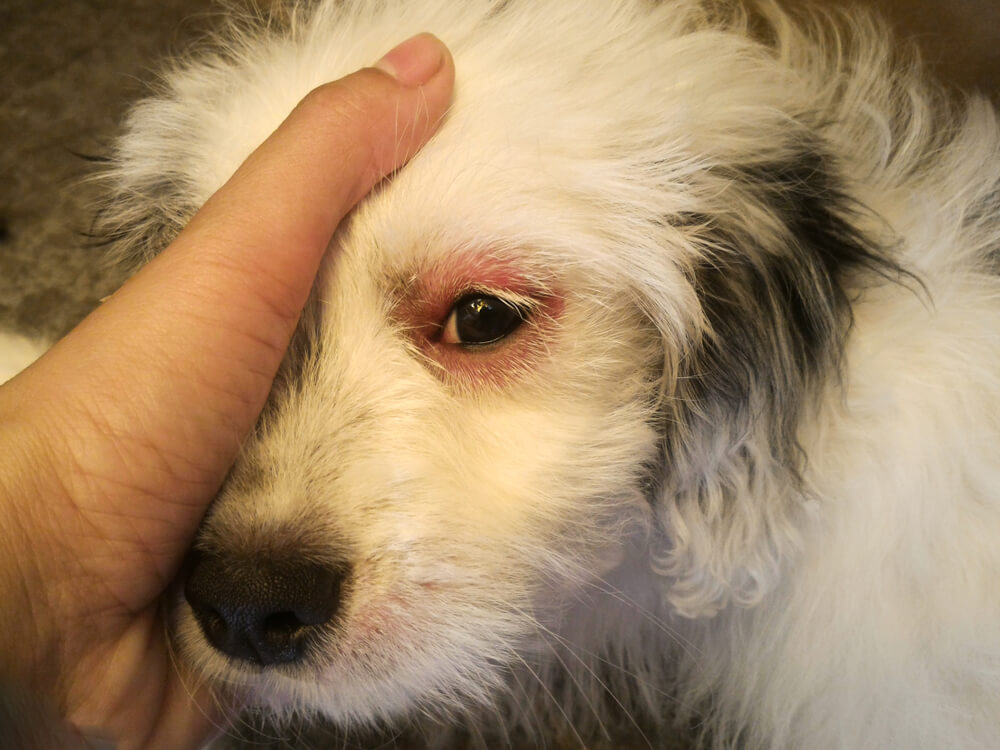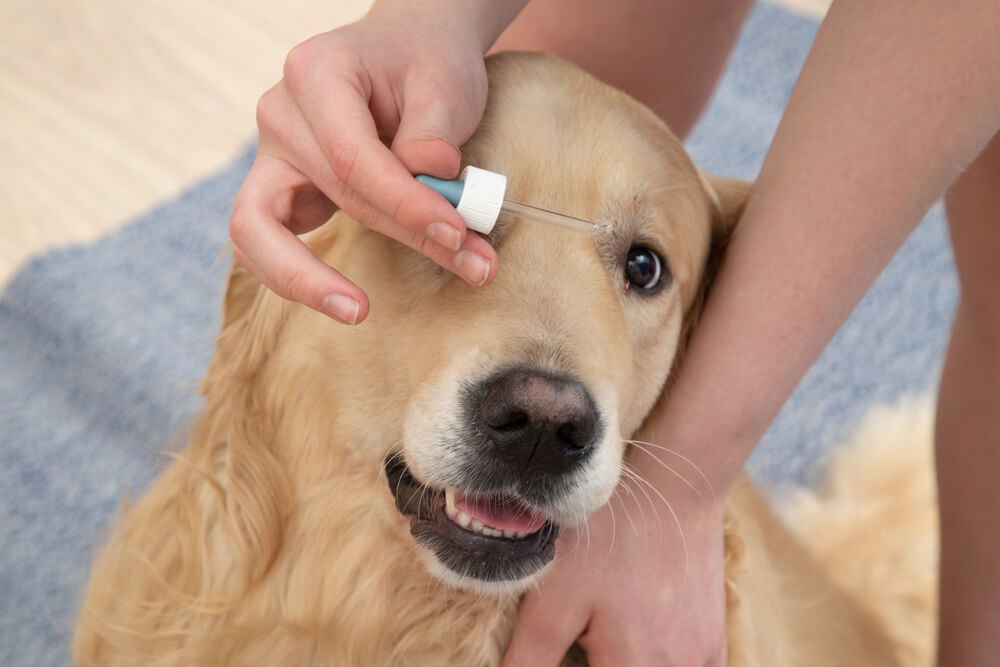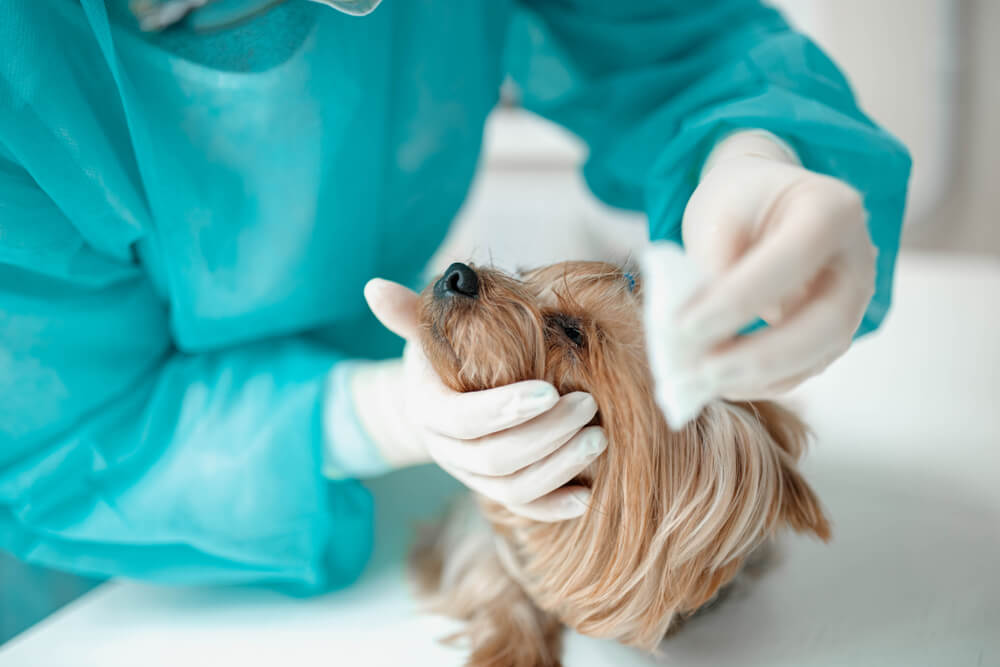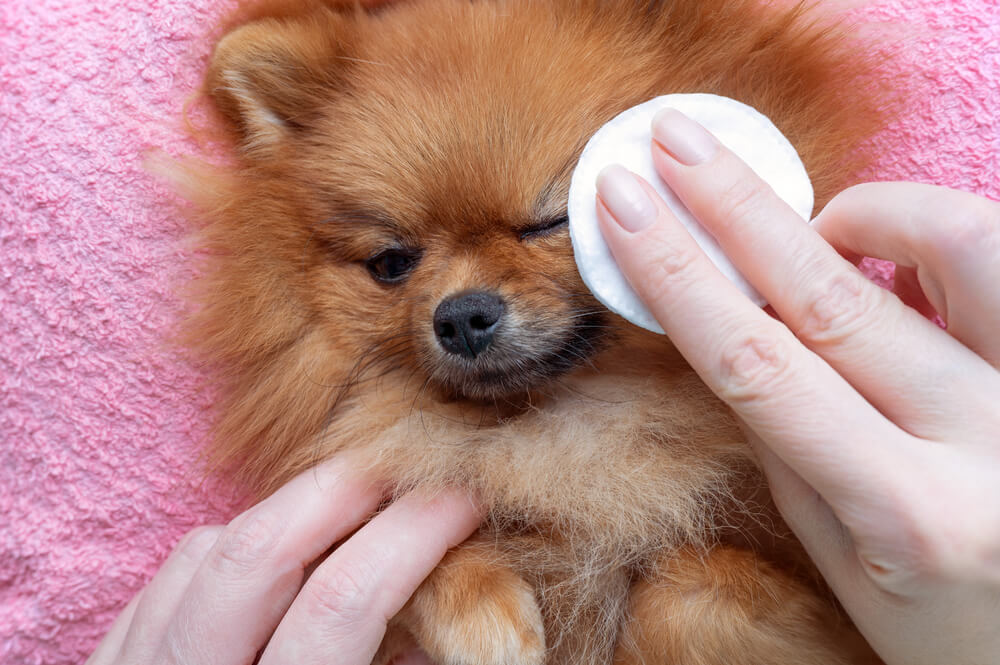Dog Eye Infections: What to Do and When to Worry

Table of Contents
Listen To The Article
Introduction to Dog Eye Infections:
What to Do and When to Worry
Like people, dogs can get eye infections and inflammation. Eye infections can occur in your dog when you least expect it and they may be difficult to spot.
When you notice redness or discharge in your dog’s eye, how can you tell if it’s allergies, an infection, injury, or irritation?
Your dog’s eyes can become infected by bacteria or viruses, or inflamed by irritants.
It’s important to first work with your veterinarian to determine the cause of your dog’s eye infection.
Then they can determine if there might be another underlying condition that allowed your dog’s eyes to get infected in the first place.
There are many causes of eye infections in dogs.
If your canine pal is exhibiting discomfort, redness, or even sensitivity to light, it’s a good idea to consult your veterinarian.
Left untreated, eye infections can spread or lead to vision loss.
Ensuring proper treatment and care for your dog’s eye infection and any underlying conditions is important for maintaining your dog’s comfort and their eye health.

Symptoms of Dog Eye Infections
Common signs and symptoms of an eye infection in dogs include:
- Redness: the eye appears pinker or redder than normal
- Discharge: varies with the type of disease
- Clear discharge is usually the cause of viral infections or allergies
- Mucoid to mucopurulent (cloudy or yellowish) discharge could be dry eye disease
- Purulent or thick yellowish-green “pus” could be a bacterial infection
- Squinting: increased blinking or spasms of the eyelid or light sensitivity
- Pawing at the eye: can indicate itchiness or pain
- Swelling of eyelids: one or both eyelids look puffy
You will usually see multiple signs occur at once, like a red, squinty eye.
This is because if the eye is infected with bacteria then the immune system will react with inflammation (discharge, redness, and/or swelling), which can also be painful (causing pawing and squinting).
Dogs with allergies, a corneal ulcer, dry eye, or trauma could look similar to this, so it’s important to have your dog undergo a complete ophthalmologic exam if you’re concerned.

Causes of Dog Eye Infections
There are two main causes of dog eye infections: viral and bacterial.
Bacterial is far more common.
Bacterial eye infections are caused by unicellular microscopic living organisms and usually need an opportunity to infect the eye.
Viruses (infectious agents made of protein and nucleic acid), trauma to the eye, or dry eye disease, can provide the perfect opportunities for bacteria to invade and grow because there is a compromise in the local defenses of the eye.
A dog’s eyes do an excellent job of self-cleaning with the tear film.
Thus, when bacteria contaminate the eye, it’s rarely due to the bacteria alone and probably related to something compromising the eye’s integrity.
The most common cause of eye infections in dogs is a bacterial infection resulting from an injury, like a scratch or ulcer on the eye.
Many times a dog will get scratched in the eye by a claw or in rough play and the wound on the cornea (the transparent layer forming the front of the eye) gets infected with bacteria that prevent it from healing.
You’ll see your dog squinting from the pain but usually, you won’t see the wound itself.
Bacterial infections can also result from unwelcome visitors entering your dog’s eye.
Foreign bodies such as fur or hair sticking into the eye can sweep bacteria into the eye, causing an infection.
Other foreign bodies include dust, debris, or plant material.
These items can get lodged under your dog’s third eyelid (the dotted T-shaped organ in the diagram above) and cause irritation and infection unless removed.
Eye abnormalities that can predispose your dog to bacterial infections include eyelids that turn inward or outward (think Basset Hounds), eyelash irritation, or tumors of the eyelid.
Abnormal tear film can also predispose a dog to bacterial infections as well as dry eyes.

Signs Your Dog Has an Eye Infection
The most obvious symptom of a dog eye infection is excess eye discharge.
But not all dog eye discharge is the same. Check this list to see if it’s likely allergies or something more serious:
- Goop or Crust in the Corner of the Eye: Most dogs (and humans) get eye boogers at some point. Dried tears, mucus, dust, dead skin cells, and other irritants mat the eyes. This is normal and typically not a cause for concern unless it becomes excessive. That doesn’t mean it’s great to look at. To clean dog eye boogers safely, simply use a warm, damp cloth to soften and gently wipe away any goop or crust from the surrounding fur.
- Watery Eyes: As in humans, watery eyes can stem from dust, allergies, and other benign irritants and likely return to normal in a day or two. If the problem worsens, changes or your pup seems miserable, make an appointment with your veterinarian to rule out something more serious.
- Reddish-Brown Fur Discoloration Around Eyes: The appearance of dog eyes with brown discharge might seem alarming, but this staining near the inner eye is usually normal. Canine tears contain a pigment that can stain light-colored fur. If there’s no other sign of discomfort or infection, it’s probably normal.
- White or Gray Mucus: Light-colored mucus is typically a sign that your dog’s eyes aren’t producing tears the way they should. In response, his eyes overproduce mucus to keep the eyes hydrated, but it’s not enough to prevent irritation. Schedule a visit with your vet to diagnose the issue. She’ll likely prescribe dog eye drops or artificial tears to keep your dog’s eyes moist and healthy and prevent further complications.
- Yellow or Green Discharge: If your dog has yellow or green eye discharge, it’s likely an eye infection, especially if the eyes are also red or swollen. Eye infections can cause serious complications if left untreated, so seek veterinary care right away.
Certain breeds are more prone to eye conditions that lead to infection.
For example, breeds with drooping skin like shar-peis, bulldogs, and mastiffs can develop eyelid problems that cause irritation.
Breeds with shortened snouts and bulging eyes, like Shih Tzus, pugs, and bulldogs are prone to corneal issues.
Still, eye infections can affect all breeds and dogs of all ages, so keep a lookout for symptoms and schedule an appointment with your vet if you notice anything unusual or if your pup doesn’t seem her normal, happy self.

How Veterinarians Diagnose a Dog Eye Infection?
Eye exams for dogs are very similar to those for humans. A dog’s eye exam may consist of the following tests:
- Schirmer Tear Test measures the eye’s tear production and will be conducted when there is redness or discharge.
- Visual examination with a focal light source of the eyelids and front half of the eye.
Intraocular pressure (IOP), measured with an instrument called a tonometer, to look for signs of glaucoma - Dilation with special eye drops allows the vet to examine the back of the eye, including the condition of the optic nerve and retina and the reflectivity of the tapetum, a layer of tissue in the canine eye that reflects light and improves night vision.
- Corneal staining with a fluorescein dye will reveal ulcers or other breaks in the surface of the cornea.
- Bacterial culture
- Allergy tests

What About Viral Eye Infections?
Canine distemper virus can cause a viral eye infection.
Viral infections are usually self-limiting unless accompanied by a secondary bacterial infection.
As a dog owner, you don’t need to be worried about viral infections if you get your dog regularly vaccinated.
Viral infections in the eye can look like bacterial infections eventually, but with viral infections, you might notice other additional signs also such as lethargy, nasal discharge, and a fever.

How to Treat Eye Infections in Dogs?
Treatment for eye infections in dogs depends on the cause. It’s essential to visit your veterinarian to determine the cause and begin appropriate treatment. Your vet may prescribe eye drops and/or ointment to treat the infection, promote healing, ease any discomfort or itchiness, and possibly treat the underlying condition.
If an injury occurred to the eye, pain medication may be prescribed. If their eye infection is deeper within the eye, certain oral medications and/or injections may also be prescribed.
If your dog has an eye infection, you can do some things at home to improve their comfort level.
- Keep the eye area clean. If there is a buildup of discharge around your dog’s eyes, cleaning the area can help promote healing. Gently wipe the area with a clean, soft cloth moistened with just warm water. Do not use any peroxide, chemicals, or human makeup removal pads. Do not touch their eyeballs. If you’re not able to easily remove the discharge, or there is debris inside their eye, contact your veterinarian. There may be some complicating factors that need attention.
- Use the cone. Your veterinarian may prescribe a cone for your dog to wear during the treatment of their eye problems. A cone can help ensure that the treatment will have the best chance of working and that your dog won’t further damage their eye(s). If your dog is having trouble adjusting to the cone, talk to your veterinarian about suggestions or other alternatives before discontinuing its use.

When It’s Time to Call the Vet?
If your pup is rubbing or scratching at her eyes, or if they appear red, painful, or swollen, it’s worth a trip to the vet to assess the situation.
The first step is seeing your veterinarian and pursuing referral to a veterinary ophthalmologist if the doctor deems it appropriate.
Because of the range of underlying causes, it’s important to get a correct diagnosis and determine the most efficient treatment plan.
A thorough eye exam, including measurement of tear production, intraocular pressure, and checking for possible corneal abrasions, usually determines the cause of chronic discharge.
Targeted therapy toward the underlying cause of the eye irritation is essential in managing and reducing the discharge.

Preventing Dog Eye Infections
There are a few steps you can take to prevent eye infections in your dog:
Avoid trauma to the eye or the introduction of foreign bodies.
One good way to protect them is to close the window when you are driving.
Dust, seeds, and other foreign bodies can fly into the eye on the wind.
- Trim hair around the eye so that it won’t irritate the eyeball.
- Keep your dog’s face clean.
- Protect the eyes with goggles designed for dogs.

How to Keep Your Dog’s Eyes Healthy?
Your dog’s eyes are precious.
Keep them healthy with a few simple practices.
First, if your dog has long hair, keep it trimmed around her eyes to avoid irritation.
Always use blunt-tip scissors held parallel to the eye and trim only when she’s calm and still.
It’s also important to keep your dog’s eyes clear of debris and mucus.
Keeping a dog’s eyes clean on a daily basis is similar to how to clean a dog’s eye infection:
- Apply a clean, warm cloth to the area to loosen and soften any eye boogers or crust in the surrounding fur.
- Gently wipe the area clean, being sure to avoid rubbing the eye itself.
- Keep your pup happy and healthy with routine eye care and be sure to note any changes in the appearance of her eyes.
And remember, eye care is just one part of your dog’s overall health.
Schedule an appointment with your veterinarian to ensure your furry friend is up-to-date on all preventatives, medications, and vaccinations.



